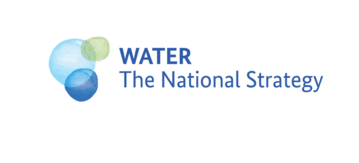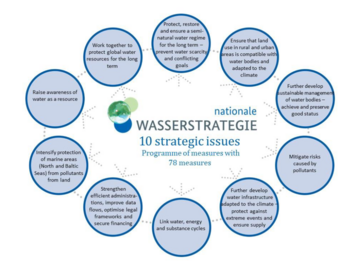Background information on the National Water Strategy

A crisis-proof strategy for our water
Water is the basis for all life and an indispensable resource for humans and the environment. However, our water resources are increasingly coming under pressure. The summers of drought between 2018 and 2022 had serious impacts on a range of areas in Germany, such as our flora and fauna, agriculture, water-dependent industries, trade and the transport sector. Periods of heat and drought, heavy rainfall and flood events will become increasingly frequent as a result of the climate crisis. This is the new reality we have to deal with. That is why we are investing in our future today. With the National Water Strategy, together we will achieve the water transition – transforming water management in Germany. We want to ensure that access to water remains secure and affordable everywhere, in future too.
The water sector in Germany is also facing huge challenges in water conservation and the modernisation and adaptation of its infrastructure. The National Water Strategy now systematically ensures that water resources are used more responsibly because "We protect what we value: water".
"We want to store and use water locally in order to restore natural water cycles. To this end, we plan to revive natural landscapes in rural areas, and de-seal and green towns and cities wherever possible so we can store rainwater and be better prepared for heavy rainfall (sponge city)."
Federal Environment Minister Steffi Lemke
The goals of the National Water Strategy
For the first time, the National Water Strategy brings together water-related measures across all relevant sectors: agriculture and nature conservation, administration and transport, urban development and industry. Also for the first time, all stakeholders are on board: the federal government, the federal states and municipalities and all economic sectors and groups that use water. The Strategy plays a key role in embedding #WaterInAllPolicies. That means putting water centre stage in a range of policy areas with direct or indirect links to water. This is the only way to achieve the water transition necessary to make us water resilient in the face of the climate crisis and other challenges, and to permanently meet our need for a reliable water supply. Because "we protect what we value: water".
As the strategy is implemented, these stakeholders will work together to restore a semi-natural water regime and make the water sector resilient to climate change. To ensure broad-based support, the Federal Ministry for the Environment, Nature Conservation, Nuclear Safety and Consumer Protection (BMUV) coordinated the strategy both within the federal government and with the federal states and associations, experts and members of the general public.
Key goals of the National Water Strategy:
- Even 30 years from now and beyond, high-quality and affordable drinking water is readily available at all times, everywhere and in sufficient quantities in Germany.
- Water quality is guaranteed – groundwater and water bodies like lakes, streams, rivers and oceans are cleaner. The polluter-pays principle and resource efficiency play a greater role in wastewater management.
- The semi-natural water regime is more resilient and has been restored.
- The water supply and wastewater disposal infrastructure are adapted to the impacts of the climate crisis.
Measures for modern and reliable water infrastructure
The water strategy covers the period up to 2050. To reach the set goals, it relies on a combination of support, legal provisions, knowledge building and dialogue. For ten strategic issues, it describes how our approach to water can be viable for the future. In addition, in cooperation with the federal states, municipalities and other stakeholders in the water sector, we are gradually implementing a programme comprising 78 specific measures.
The challenges for water management are diverse and complex. The solutions and options for transitioning to future-proof water management are similarly complex and interlinked. The strategic issues were intentionally selected to tackle the challenges and implement solutions across sectors and action areas.
Infographic: The ten strategic issues of the National Water Strategy

The 10 strategic issues of the National Water Strategy:
The path from the strategy to implementation
The first programme of measures will be gradually implemented between now and 2030. First steps are already underway. These include:
- Developing a national guideline for dealing with water scarcity. Together with the federal states and in dialogue with stakeholders, a uniform framework for setting priorities in local and regional decision-making will be created. The aim is to ensure that sufficient resources for drinking water are available at all times in the closest possible proximity.
- Dovetailing with funds from the Federal Action Plan on Nature-based Solutions for Climate and Biodiversity. This includes the funding guidelines expected to be published this year on climate-related measures in water body development.
- The transformation to water-smart cities is already underway and the federal government is currently supporting municipalities that promote water-smart urban development. The federal government and federal states are working intensively on implementing the White Paper on Urban Greenery. They are developing an action plan for green-blue infrastructure that will incorporate measures from the National Water Strategy to implement the guiding principle of water-smart urban development.
- The Federal Institute of Hydrology (BfG) is developing a national, user group-specific low water level information system (Niedrigwasserinformationssystem, NIWIS). This data, analysis and reporting system will serve as a central, publicly accessible data and information hub for the federal government, federal states and other users and will provide information for planning decisions, etc.
- The Federal Environment Ministry has launched the water communication strategy, aimed at raising public awareness about the use of water as a resource.
- Furthermore, since the adoption of the National Water Strategy, a number of principles are being elaborated in research projects as vital preparation for implementing individual measures.
- Other relevant actors in the water sector include the federal states and associations, and they have already joined us in advancing the National Water Strategy by launching their own projects.
The path from dialogue and scientific findings to the draft
The National Water Strategy is the result of intensive discussions with representatives of the federal states, participating associations, NGOs, the scientific community and members of the public in the National Water Dialogue and with the ministries.
The draft National Water Strategy was coordinated within the federal government. To this end, the stakeholders were consulted and had until 19 December 2022 to comment with specific input and proposals.
This was preceded by a Federal Environment Ministry draft, presented at the 3rd National Water Forum on 8 June 2021. The ministry’s draft National Water Strategy was based on the results of the two-year National Water Dialogue, which involved more than 200 participants from the water sector, agriculture and research institutions and from associations, the federal states and municipalities. The national citizens' dialogue on water contributed further ideas and gathered policy demands from the public.
The scientific basis for the draft National Water Strategy was compiled by the German Environment Agency as part of a research and development project. It includes information on the status of water bodies, challenges and requirements for water management and water conservation, and water uses in other sectors.
